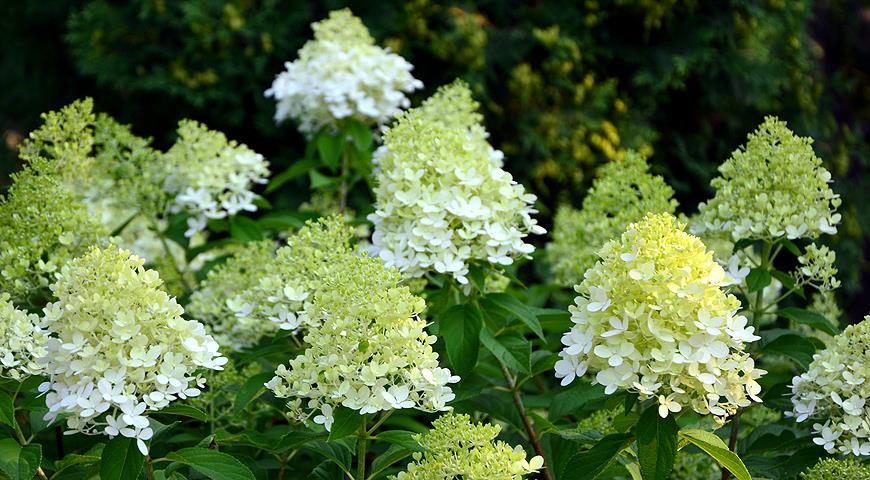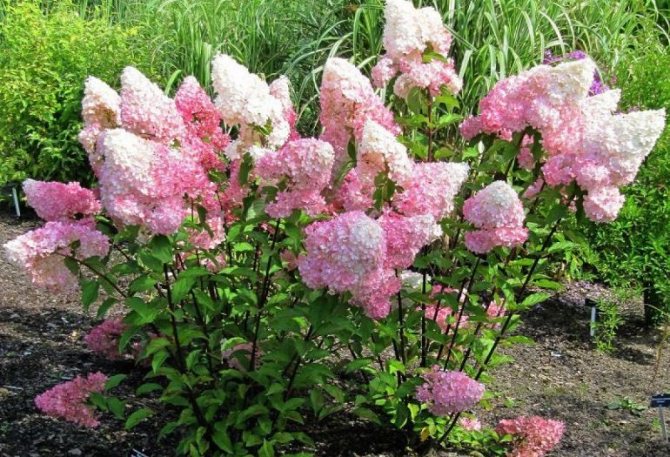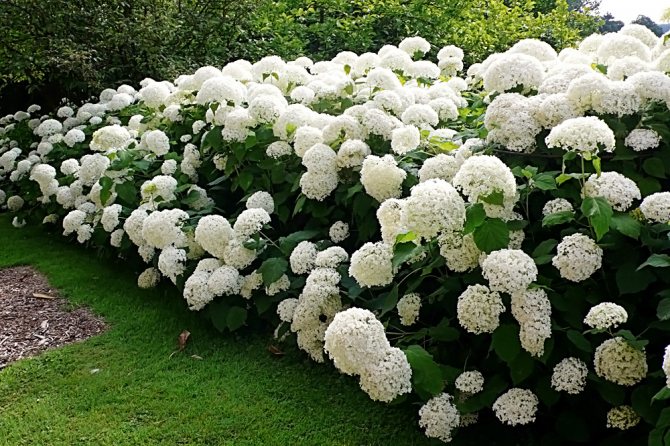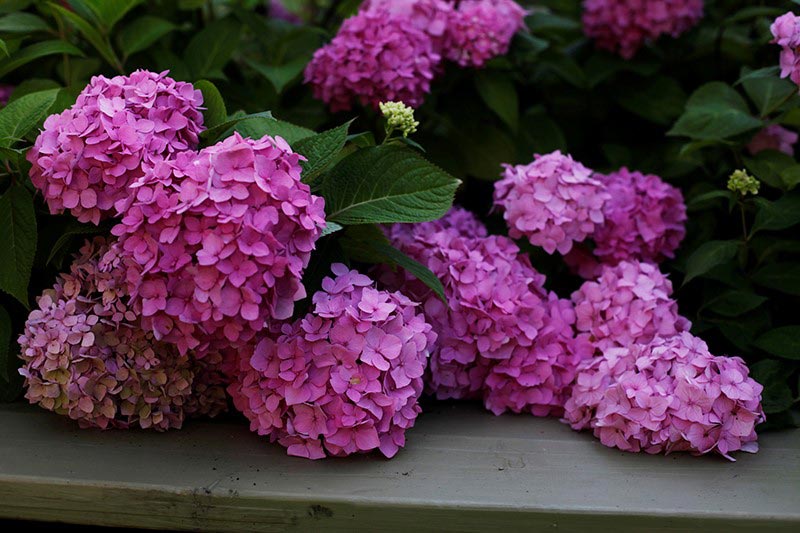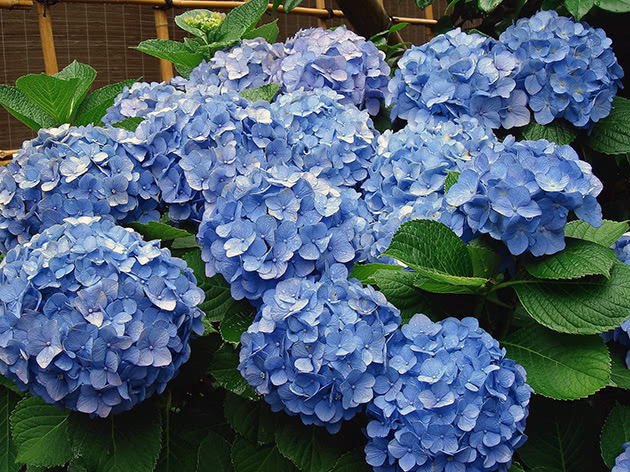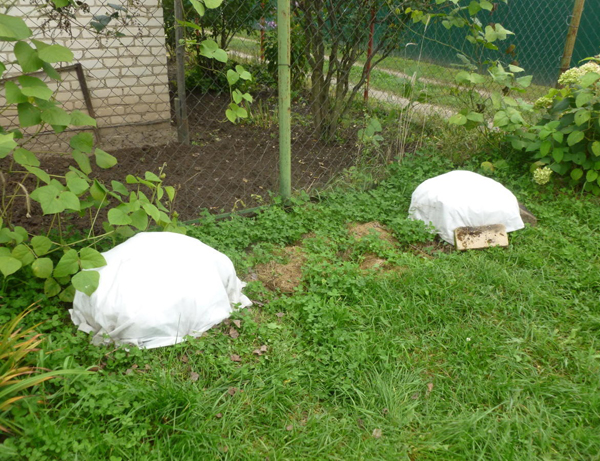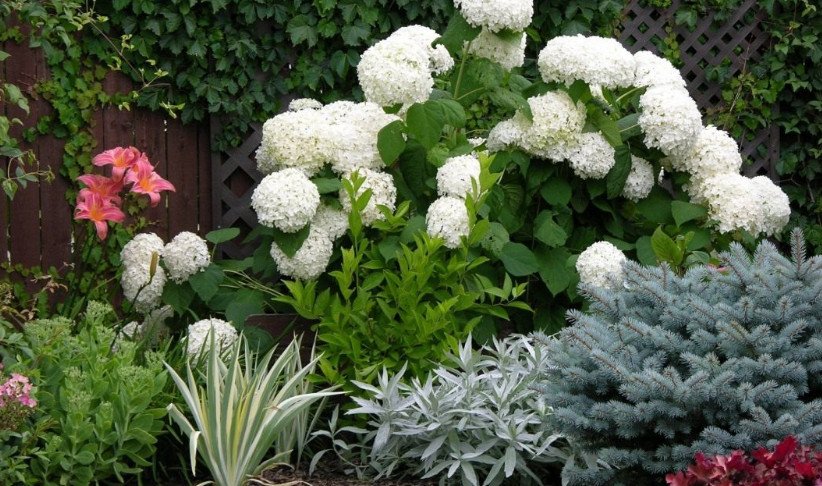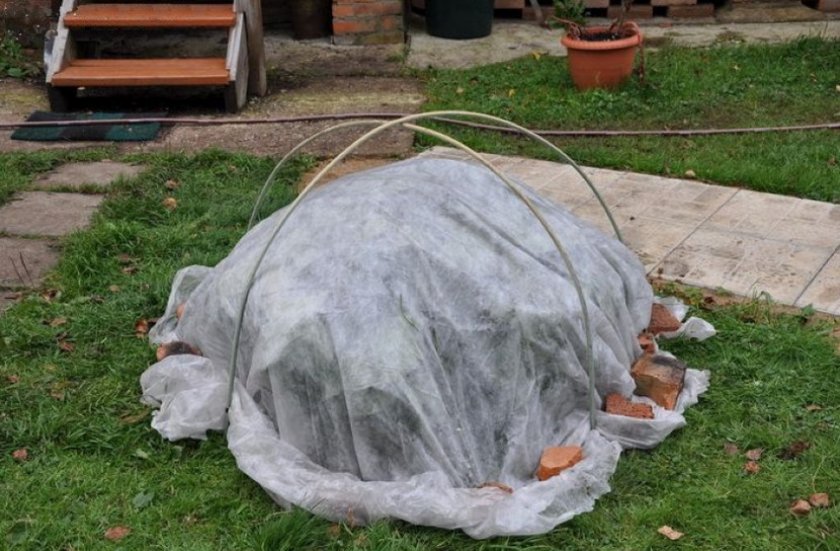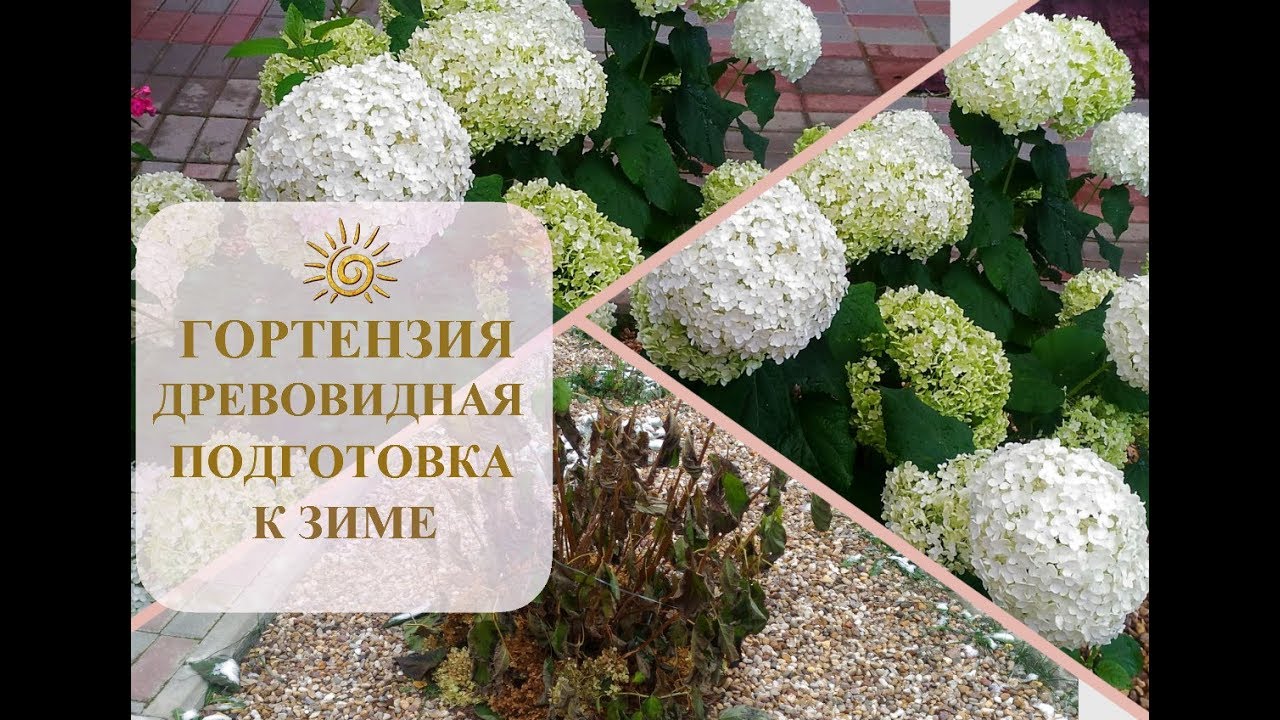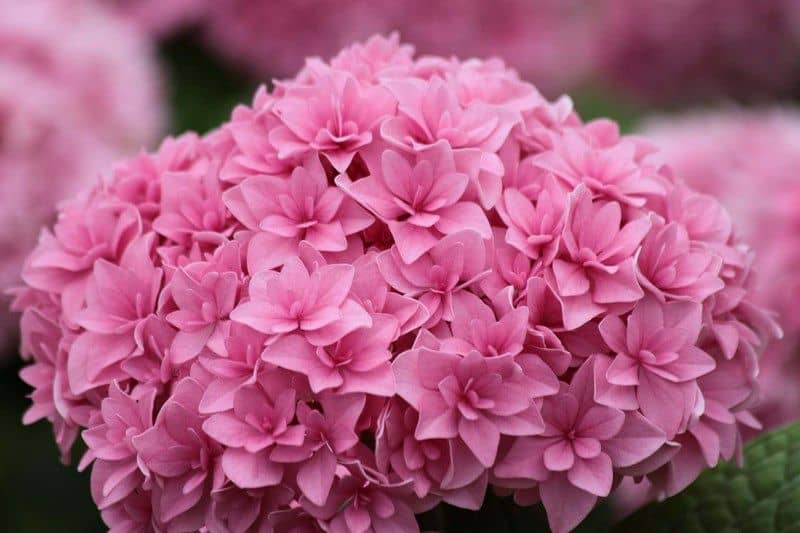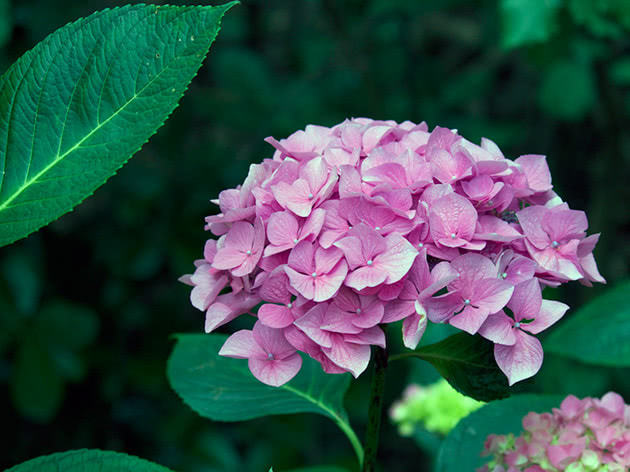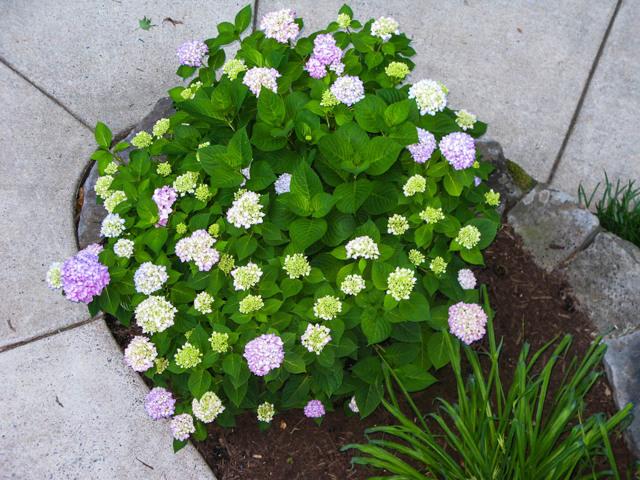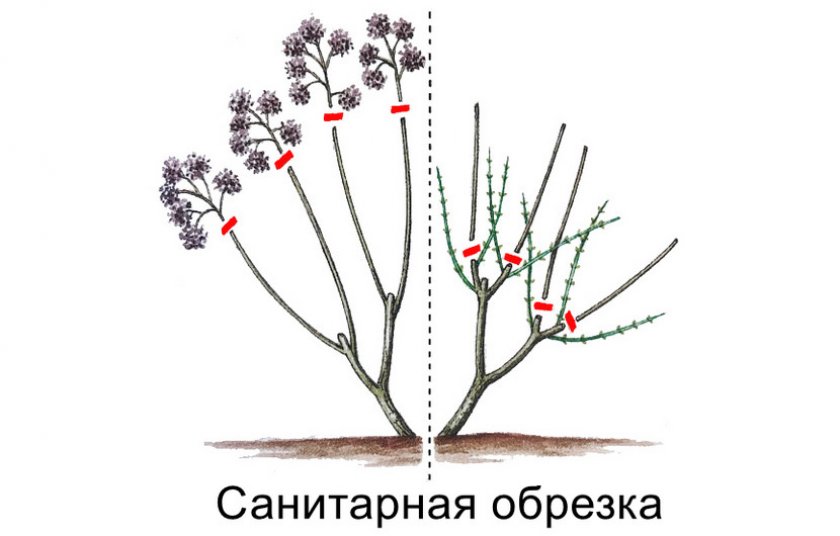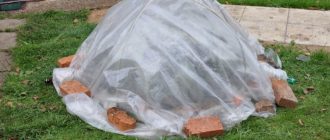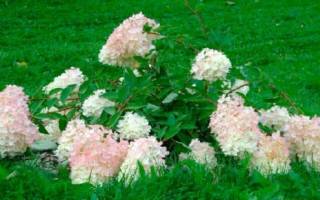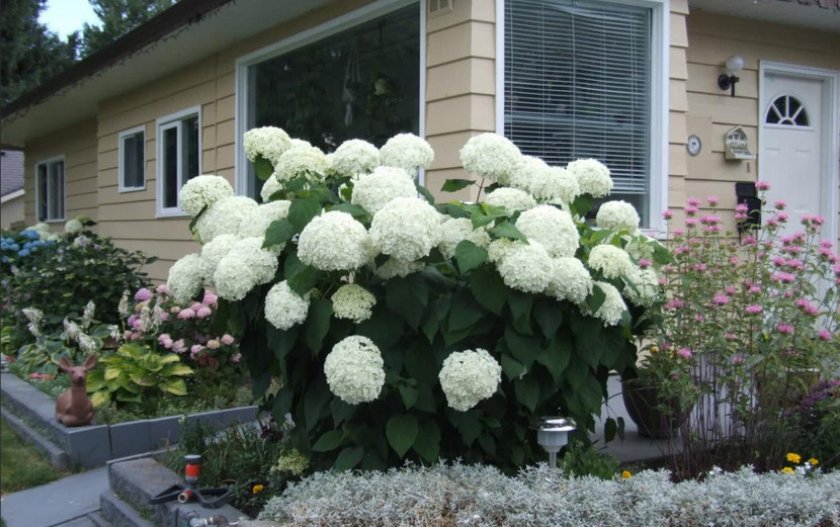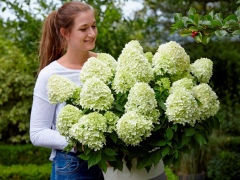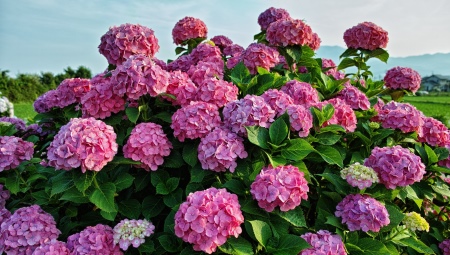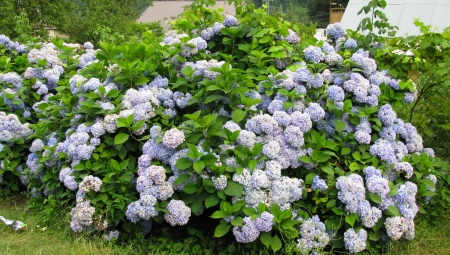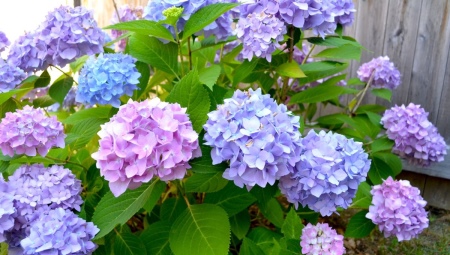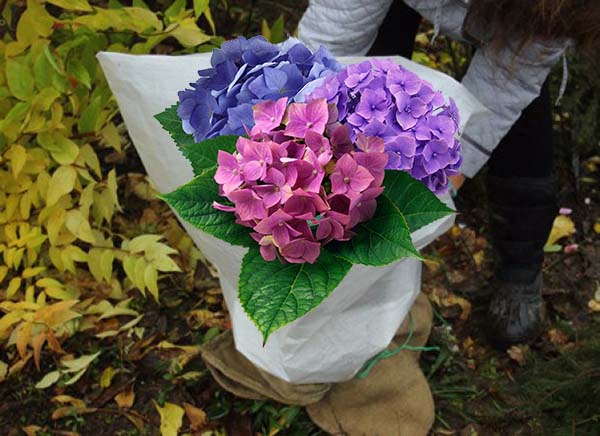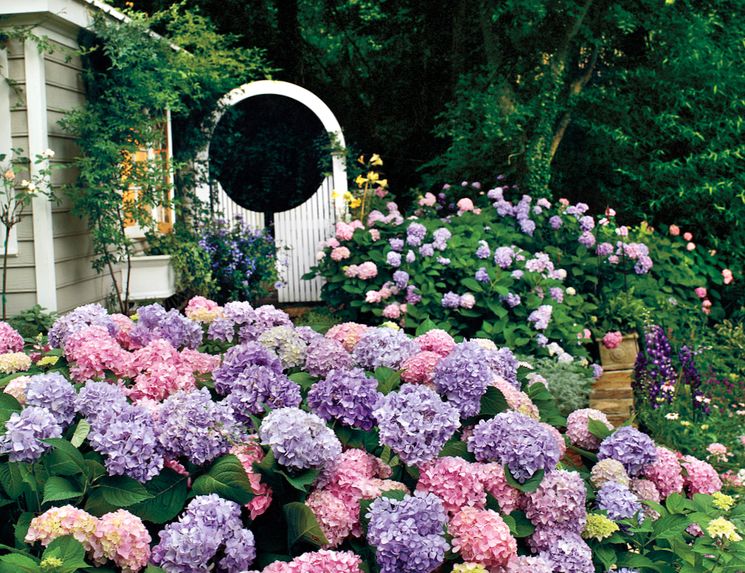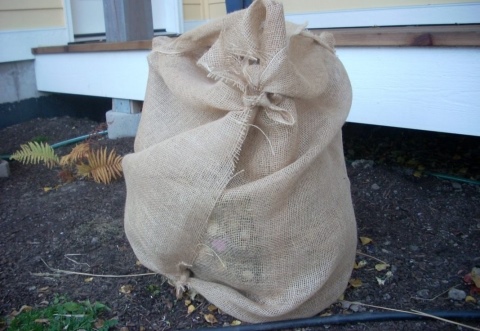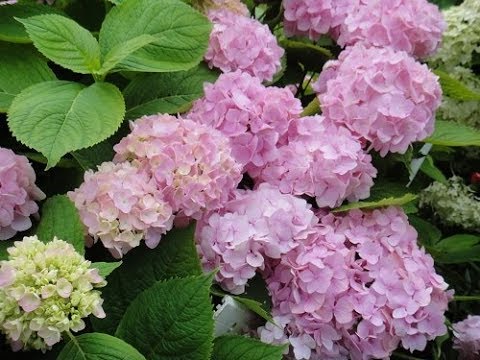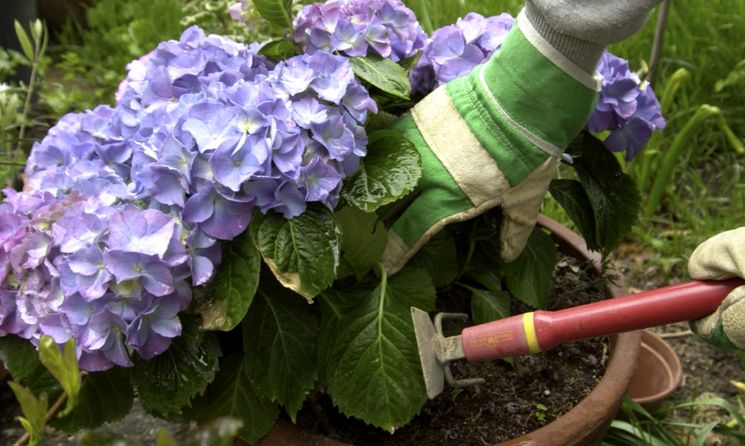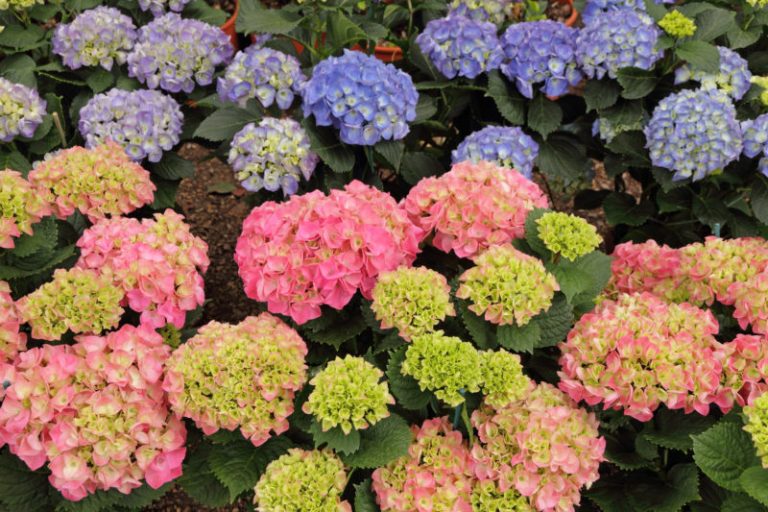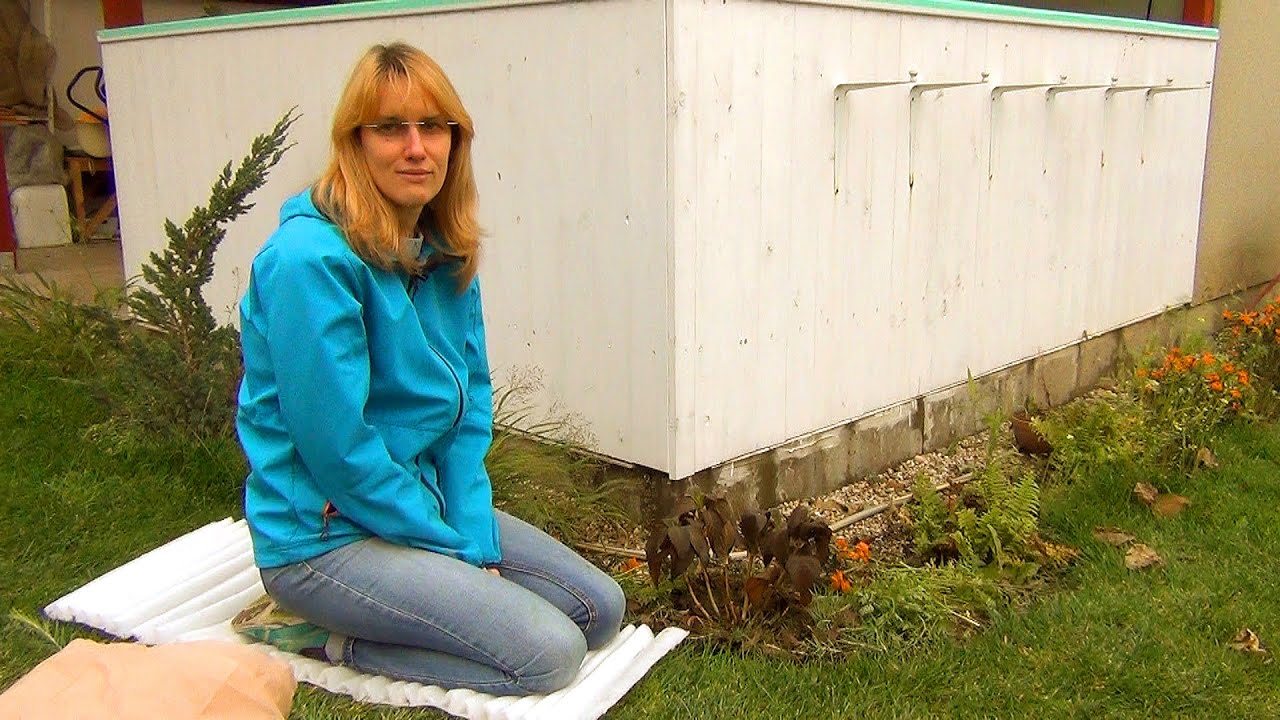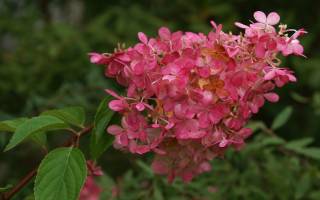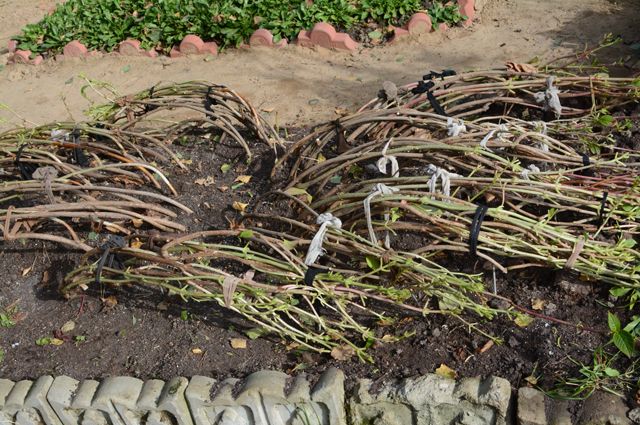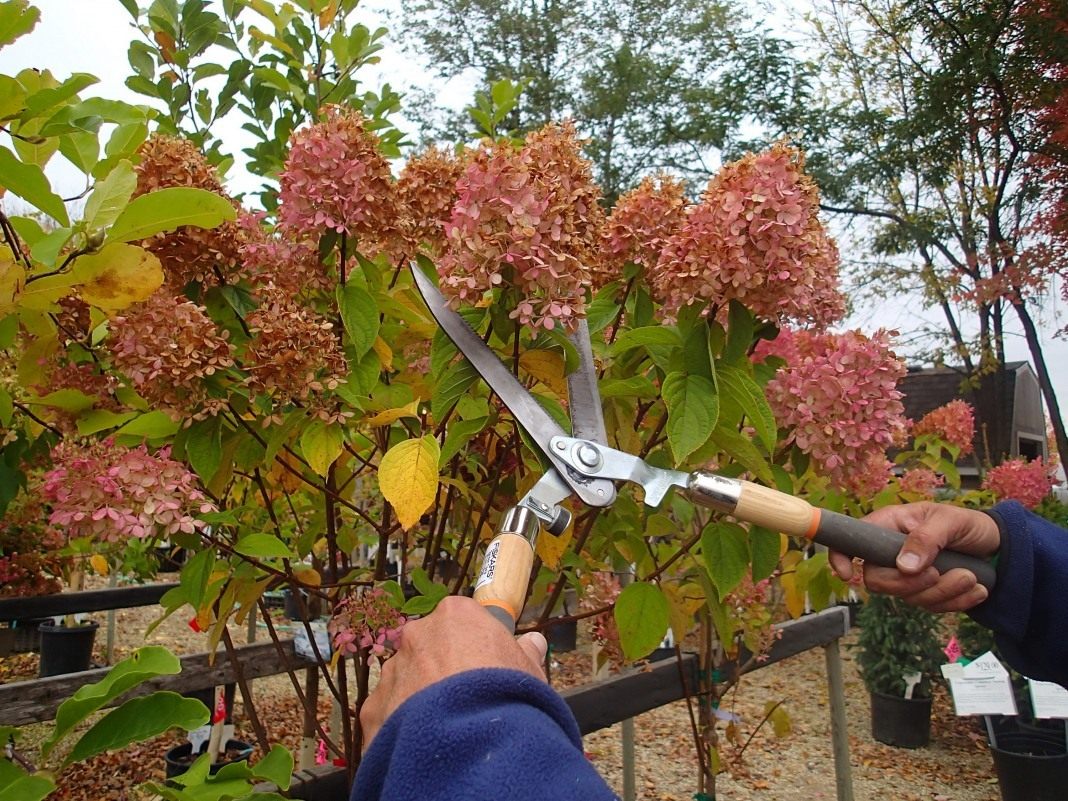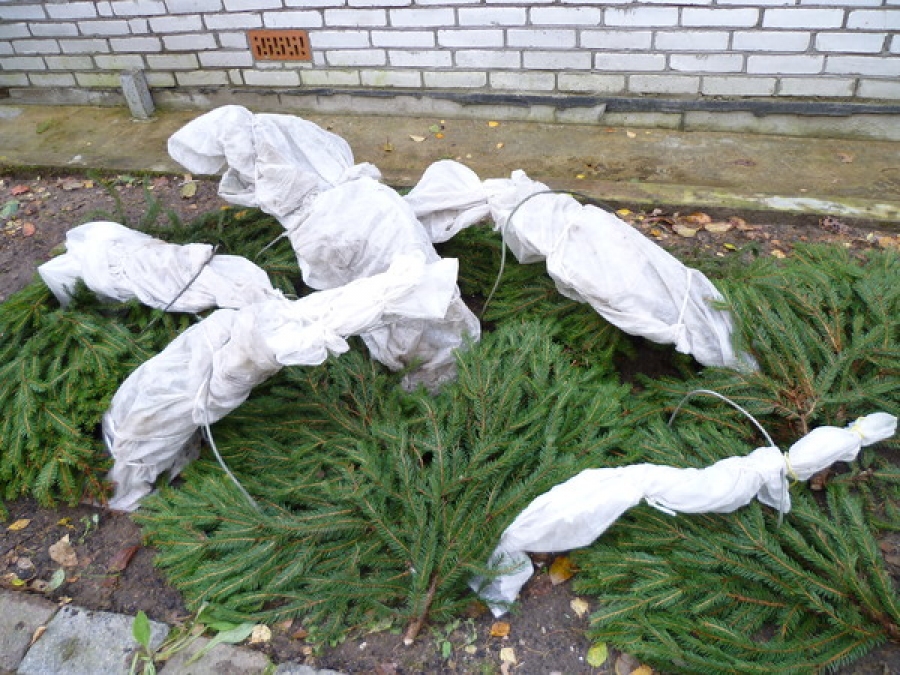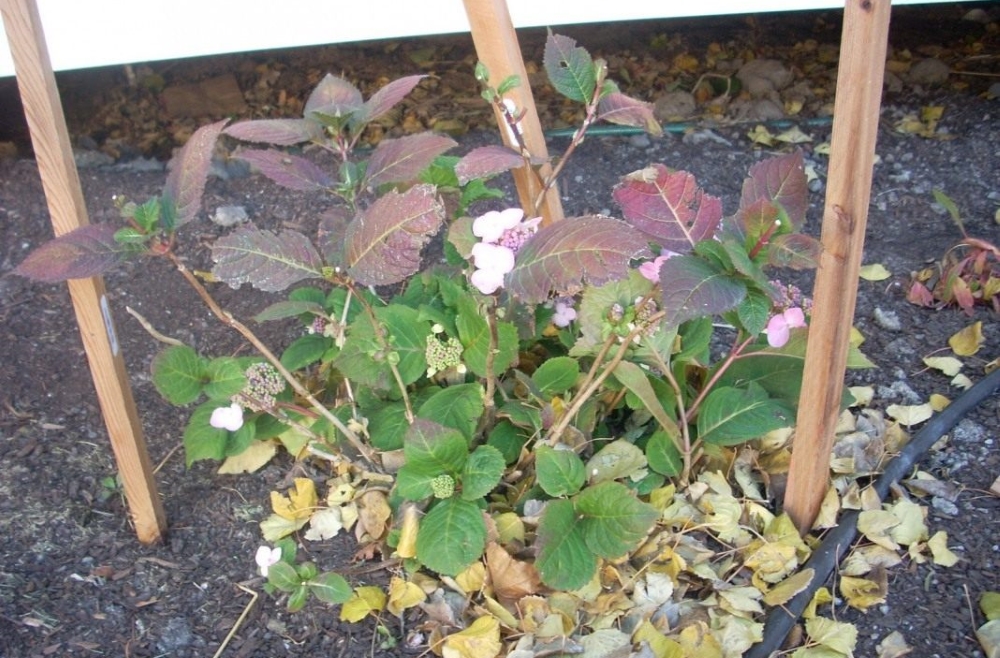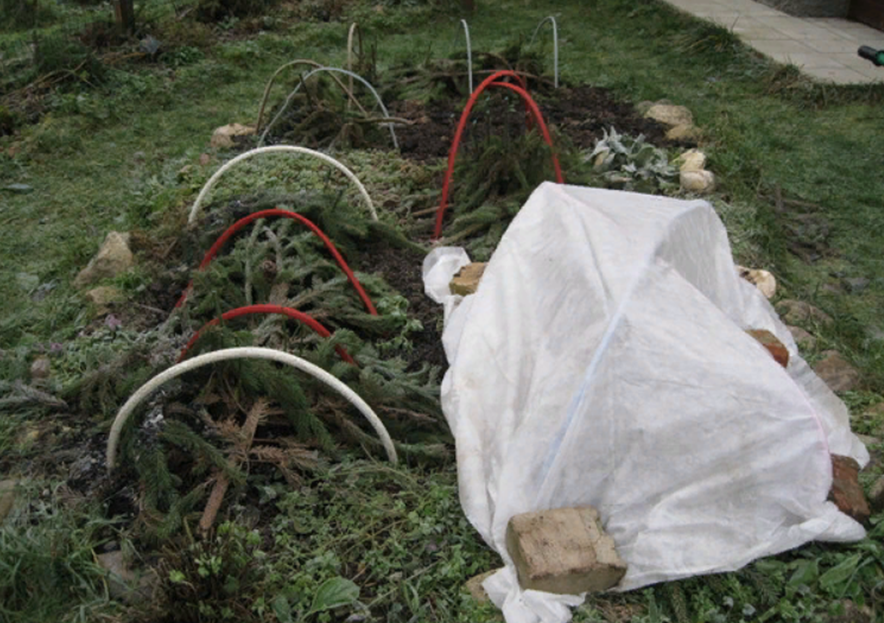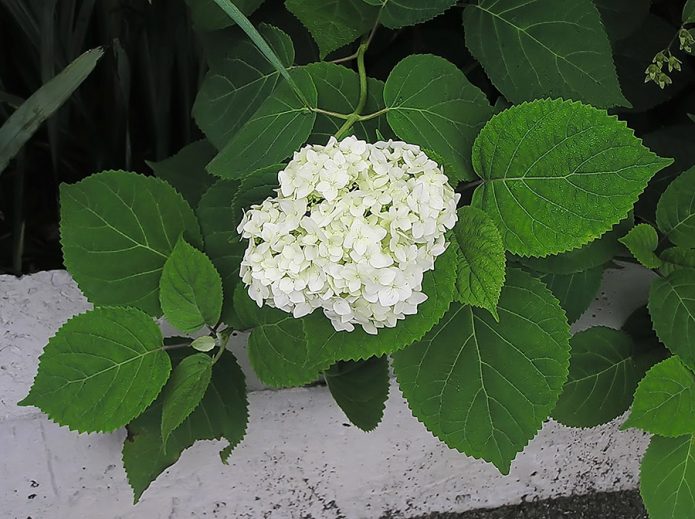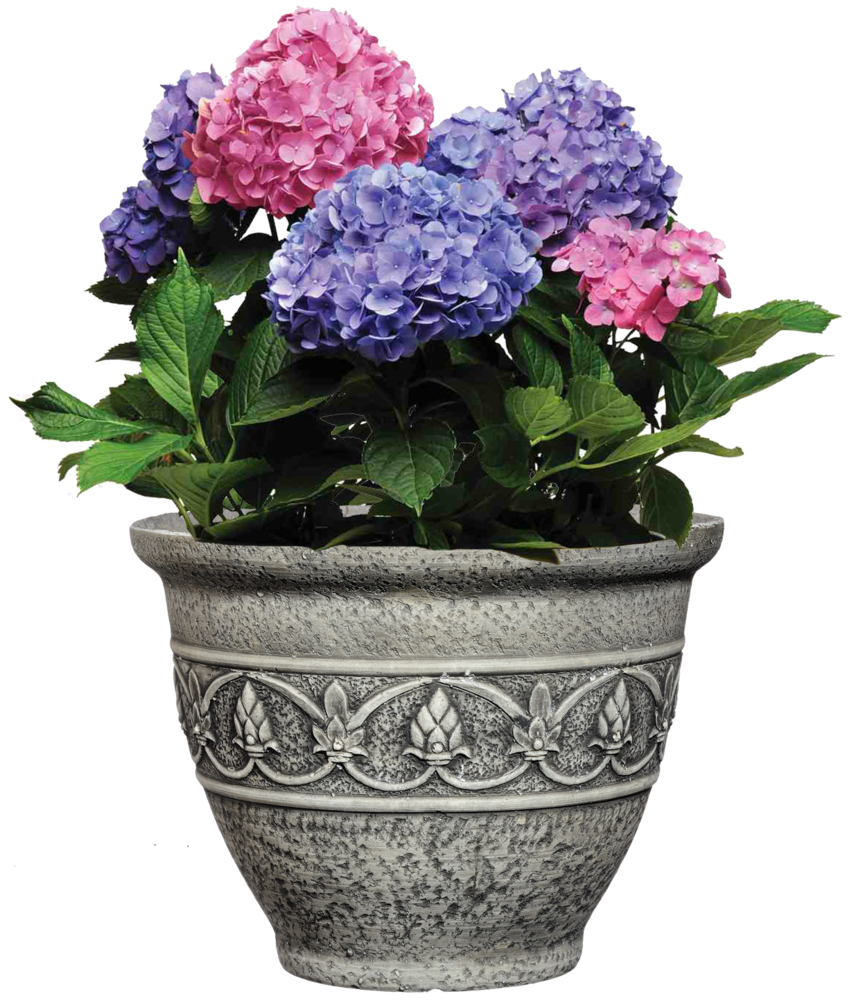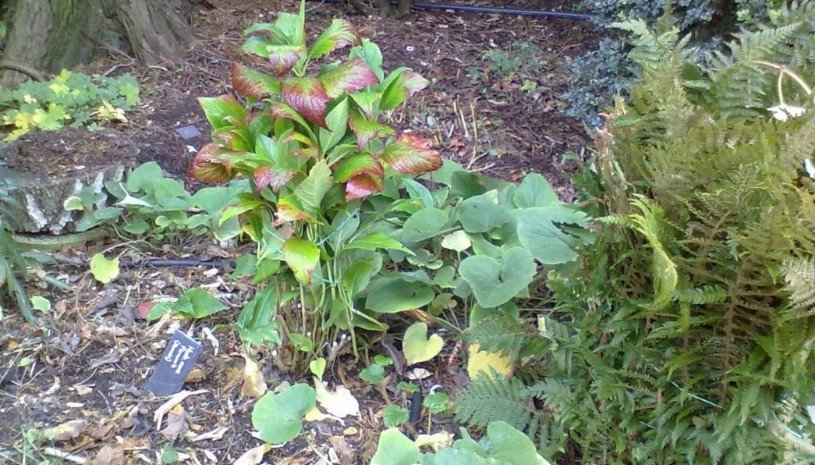How to properly prepare hydrangeas for winter: shelter and mulching
Of course, maintenance activities such as pruning, preventive spraying, and fertilizing help the flower culture to prepare for the frost in the fall. However, there are specific measures aimed at preparing the plant for winter, these include mulching and shelter.
Shelter for the winter is the most important component of care, which helps protect the shrub from bad weather and frost. However, not all types of flower culture need shelter:
- Panicle hydrangeas do not cover, they are distinguished by excellent winter hardiness.
- Treelike hydrangeas also do not need shelter, they tolerate frost well.
- Large-leaved hydrangeas (garden) should be covered without fail! It is not frost-resistant, if its flower buds freeze and die, then next season you will not see flowering.
- Oak-leaved and serrated species also need shelter.
Mulching paniculate and tree hydrangea
As mentioned above, paniculate and tree hydrangeas are a frost-resistant crop, so they do not need shelter. However, in preparation for winter, you need to mulch the trunk circle in the fall. Mulch plays an important role - it protects the root system from freezing in winter.
It is best to use a mixture of coniferous litter, peat (preferably high sour peat or at least neutral lowland peat) and compost as mulch. Coniferous litter and high moor peat are important because they acidify the soil, and hydrangea loves acidic soils.
If it is not possible to combine these components at once, then at least a mixture of compost and peat / peat or coniferous litter / compost or coniferous litter should be used. Or just use one peat or compost. As a last resort, if you do not have such ingredients, then you can mulch at least with ordinary soil, which was taken from another place on your site.
Mulching paniculate and tree hydrangea should be done using the hilling method. The height of the mulch should be about 15 centimeters, while covering the center of the bush and the area around the bush with a protective layer at a distance of 30-40 centimeters in radius.
Shelter of large-leaved hydrangea
Large-leaved hydrangea is afraid of frost, so it needs careful preparation for winter and good shelter. This variety blooms on the shoots of last year, and if the flower buds freeze in the autumn or winter period, then you will not see flowering.
Shelter must be done before the first frost, because minimum freezing temperatures can negatively affect flower buds. Therefore, the optimal time for sheltering large-leaved hydrangea is at a temperature of 6-8 degrees Celsius during the day, at 2-4 degrees Celsius at night. Estimated time of the procedure in different regions:
- In the Central lane (Moscow region) - the first half of October;
- In Siberia, in the Urals, in the North-West (Leningrad Region) - late September, early October.
The best way to shelter a large-leaved hydrangea for the winter:
- All leaves are removed from the shrub.
- Then all branches are neatly tied with twine.
- The bush must be wrapped in spunbond in two layers (while the density of the covering material must be at least 60). Spunbond is also fixed with twine.
- Around the bush, it is necessary to make a frame of mesh, it should be 15 centimeters higher than the connected bush and always wider.
- Then the frame should be filled with dry leaves, they should fill its entire volume.
- After that, it is necessary to wrap the frame with a moisture-proof material (for example, a film).
There is another way to hide in the fall, you need to act according to the following scheme:
- Put boards next to the bush.
- Remove the leaves and gently bend the shoots to the surface of the soil, then tie the shoots, wrap with spunbond.
- Then you should put the bush on the boards, fix them with ropes.
- Fully cover the bushes with dry leaves or sawdust, peat.
- From above, you need to fix the insulating materials with a covering material, fix it well.
- And then cover the covering material with polyethylene and fix it well.
It is very important to remove the shelter gradually in the spring in order to minimize stress on the shrub and not to deprive it of its protection in the event of recurrent frosts. By the way, in case of return of negative temperatures, you need to cover the plant back
You need to open the plant within a few days.
Hydrangea shelter methods
A lot of them are known. We will tell you about the most popular and effective ones.
In regions with a mild climate, you don't have to worry about shelter.
Throw 1-2 layers of spunbond onto the bush and press the edges of the material with stones or bricks
But young plants of fastidious varieties need to be snatched more carefully for the winter.
1 way
You need to take a wide board, the length of which is equal to the height of the shoots, and drive nails along its entire perimeter. Then tie the branches of hydrangea with rope or twine, gently tilt and lay on a board with nails placed on the ground.
Next, using a rope, the plant must be fixed and covered with dry leaves, sawdust or spruce branches on top. Covering material can be pressed down with stones or bricks. Then the structure must be covered with a spunbond, and a film must be thrown on top.
2 way
The most popular among gardeners was the air-dry shelter method. First, the bush must be wrapped in spunbond. Then, at a distance of 25 cm around the bush, put a frame made of metal mesh. The structure should be about 10 cm higher than the bush. The frame should be filled with dry leaves.
In regions with severe and snowless winters, it is recommended to cover this structure from above with a film or roofing material
3 way
You can also cover the hydrangea tree trunks with spruce branches and lay the plant branches on it. They should be placed in a circle, securing the shoots at the center with thick wire staples.
It is necessary to accustom the plant to a horizontal position gradually, after a while moving the clamps from the center of the trunks to their base. The shoots should be insulated with spruce branches, and on top of it - with spunbond. On top, you need to pour dry sawdust or peat, and then spruce branches again.
The thickness of the covering materials depends on the age of the hydrangea, its variety and the climate in your area.
To prevent freezing of flower buds, it is advisable to lay plastic bags with dry leaves along the periphery of the decomposed branches. It is worth putting the same bags under the shoots at the fold. This will protect them from breaking off. The last step is to cover the structure with a waterproof material.
4 way
Separately, it should be said about the shelter of container hydrangeas.
Hydrangea can also be grown as an indoor crop.
Shrubs in containers should be removed to any cool, frost-free room. In the absence of such, the plant must be dug in the garden.
To do this, you must choose a sunny place. The hole must be dug with a depth equal to the height of the plant with the pot plus 15-20 cm. After installing the container in it, you need to lay boards or a wooden lattice on top and lay any covering material.
To create an additional air gap, an empty box should be placed upside down over the plant, dry leaves should be sprinkled on top and everything should be covered with plastic wrap.
In the spring, do not rush to remove the shelter from the hydrangeas.Wait for blowjob threat of frost. Then your plants will remain unharmed and will certainly delight you with spectacular flowering.
Suitable materials

To shelter large-leaved hydrangea in the garden for the winter, use a variety of materials singly and in combination. This is due to the fact that even an adult 3-4 year old bush reacts painfully to negative temperatures. In the Moscow region and other regions of the middle zone of the Russian Federation, the soil is capable of freezing to a depth of more than 1 meter. The main purpose of the shelter is to prevent sudden temperature fluctuations, ensuring smooth wintering.
Leaves
It is impossible to cover the plant with leaves alone, such protection will not be enough for high-quality thermal insulation. On top of such a shelter, flooring is made of spruce branches, nonwovens or burlap. It is not recommended to use plastic wrap, if the air temperature outside rises above +2 degrees, the plant will rot.
For the organization of protection, you can not use leaves from fruit trees and shrubs collected in the garden. This is due to the fact that during the winter they rot and the necessary thermal insulation is canceled. In addition, pests and fungal spores may be present on their surface, which threaten a flowering plant. For shelter, it is better to take dry leaves from under a maple or chestnut tree.
Lapnik

Spruce spruce branches are able to provide proper protection of the culture in winter, but they must cover the plant correctly. It is permissible to carry out work after the complete removal of leaves from the branches of the bush and from under it. It is better to first cover the culture with a film, and lay the branches on top for reliability. There is another option - the branches are placed directly on the bush, and peat is poured on top of them with a thick layer. In addition to spruce branches, you can take ordinary boards of medium thickness.
Spunbond
To organize the protection of plants from frost in the garden, spunbond and lutrasil are used. This is a special breathable film. To create a shelter, supports are used, on which the material is fixed. The advantage of this method is that you can gradually add layers of material. At the first insignificant cold snaps, the hydrangea is covered with one layer of spunbond, and insulation is added as necessary (up to 4 layers).
Sackcloth
You can cover the hydrangea from frost for the winter with burlap. The material is advised to be used in 2-3 layers, because its density may not be enough. This design is optimal for the first cold snaps, after the onset of significant frosts, they cover with plastic wrap, leaving several holes for ventilation at the base. They remove the protection in the spring when the air temperature is at least -5 degrees at night.
Film
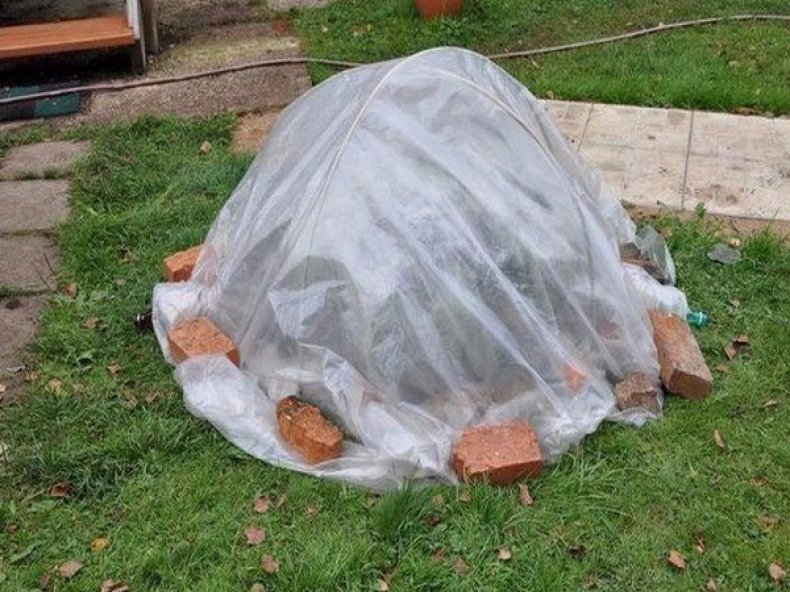
It is not recommended to use a film for protection against frost. This is due to the fact that condensation can form under it due to insufficient ventilation. The lack of a constant flow of oxygen does not have the best effect on the condition of the plant, especially when it warms in the middle of winter. In the event of a sharp rise in temperatures, the organized shelter will have to be constantly ventilated.
Attention! If it is impossible to get another material to protect hydrangia from frost, it is permissible to take a polyethylene cut. It is laid on the ground, pressed with a load, but holes are left on both sides for access
How to restore a flower in spring?
Due to the poor resistance of hydrangeas to cold weather, winter frosts can have a very negative effect on the bush, and in some cases cause its death. If the culture does not show signs of life after wintering or develops very poorly, then it is necessary to help it. Those gardeners who do not or have not been able to cover the bushes for the winter may face a number of problems.
Hydrangea diseases - from a weakened state, the bush cannot withstand a variety of diseases, of which there are a lot in spring due to the humid and warm environmental conditions.If blackening or any other stains begin to appear on the foliage, then urgent action is needed.
If the winter is cold, the tips of the shoots will be dry due to freezing. To help the plant regain strength, you need to remove all damaged parts, apply fertilizer and water the bush in a timely manner. With heavy damage, the hydrangea will not be able to bloom this year, but the bush will get stronger and please the next season.
For information on how to prepare panicle hydrangea for winter, see the next video.
How to cover a hydrangea for the winter in the Moscow region
Experienced gardeners are keenly watching fall activities such as sheltering hydrangeas for the winter. The shrub must first be cut from damaged shoots. It blooms beautifully and requires proper maintenance for its lush spring bloom. In the Moscow region, gardeners also grow a lot of hydrangea bushes. And many of them are interested in the peculiarities of working with shrubs, in particular, how to cover a hydrangea for the winter.
A shrub without constant feeding will produce only a few inflorescences on one bush. The garden area will not have a beautiful landscape. The bush, which was fed in a timely manner, and introduced various trace elements into the soil, will give you beauty during the flowering period.

How to cover a panicle hydrangea for the winter
The most stable type of hydrangea is considered to be paniculate, which is able to overwinter even in thirty-degree frosts. This variety can be completely closed and not too insulated. Only the trunk circle can be closed. This will protect the root system from frost. Therefore, panicle hydrangea for the Moscow region will be an ideal variety, as well as for the entire central zone of Russia.
Shelter work for panicle hydrangea consists of the following works:
- 1Around the bush, sprinkle loose dry earth 20 cm thick.
- 2 The combined shelter will be a humus layer of 10 cm, a layer of foliage alternating with a layer of earth.
After such protection, your flowering shrub will easily overwinter even in severe frosts.
How to cover a treelike hydrangea
This type of flowering shrub also tolerates winter firmly, but it is better to cover it completely. In the south, the treelike hydrangea is not closed for the winter. It is simply cleaned of overgrowth before winter, or these procedures are done in the spring.
Hydrangea is a moisture-loving plant, but when it rains a lot in autumn, it is better to cover it with something from the water. For this, you can sew a kind of roof over the bush from a film or waterproof fabric. This will prevent water from entering the root system.
Before sheltering the shrub, tie the branches in several bunches and bend to the ground. Before that, spread spruce branches, branches or something on the ground. Also cover the bush with spruce branches or other available material for insulation. The last layer will be a well-adhered plastic wrap.
Annual seedlings need special shelter for the winter:
- 1First, the root circle needs to be covered with dry, loose soil.
- 2Next, carefully close the young branches, as they can freeze in severe frosts. Cover them with coniferous branches or branches, and then with a film.
- 3 Hydrangeas do not tolerate wind well, so the edges of the film must be covered with earth so that the wind does not penetrate under the shelter. Place old warm clothes or a blanket on top.

In the spring, it is not necessary to remove the insulation immediately, but with short interruptions. Remove one layer every week. At the end, remove the tucked earth around the trunk. Before the beginning of May, you should not open a bush from insulation. It must be remembered that frosts often return.
List of mandatory autumn procedures
You can't just insulate the plant before the onset of frost. It must be prepared for winter rest, otherwise the culture will develop worse in the next season. The list of procedures that must be carried out in the fall include:
- Autumn feeding. Fertilizers are applied under each bush before cooling.It is better to use formulations with a high content of potassium and phosphorus. Nitrogen is not added before wintering, because this component is capable of causing an active increase in green mass.
- Watering. Additional soil moisture is stopped at the beginning of September, before that the shrub is watered abundantly.
- Autumn pruning. Mandatory preparation stage. The procedure consists in removing leaves from the hydrangia bush, pruning broken and dry branches.

After completing all the above works, before organizing a reliable shelter, the soil under the plant must be well cleaned
It is important to remove all plant debris, because sources of diseases and pests can hibernate and actively reproduce in them. In the spring they will appear and affect the vegetation of the plant.
Attention! In autumn, the hydrangea should be examined for the presence of pests and the development of fungal and viral diseases should be excluded. If problems are found, they must be eliminated before wintering begins.
Ways to hide large-leaved hydrangea for the winter
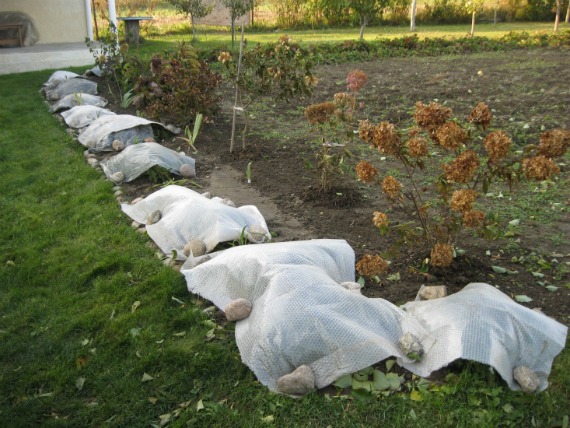 There are a lot of ways to hide hydrangeas for the winter, and each grower chooses the best one for himself, based on his own capabilities.
There are a lot of ways to hide hydrangeas for the winter, and each grower chooses the best one for himself, based on his own capabilities.
Multi-layer shelter
Any variant of the hydrangea shelter begins with mulching the trunk circle, which will exclude contact of the plant shoots with the soil and prevent the occurrence of unwanted diseases.
- The soil around the hydrangea is covered with a layer of coniferous litter, spruce branches, dry maple, chestnut or oak leaves. These types of foliage do not have time to rot during the winter, which also reduces the likelihood of disease.
- Hydrangea shoots are divided into 2 parts and tied. The bundles are bent to the ground in opposite directions and pinned to the ground. Metal staples, bent thick wire, wooden slingshots, etc. can be used as pins. If the bush is voluminous, then the division is carried out into a larger number of parts, also bent to the ground and securely fixed.
If there is time and the gardener has a sufficient amount of fastening material, then each shoot can be fixed on the soil individually by drawing a kind of sun rays from the shoots.
- The root space is filled with moss, or leaf litter, which will serve as additional protection of the root system from freezing.
- Low arcs are installed over the hydrangea and agrofibre is thrown over. This will be the initial shelter for the period of light frost.
- Then dry leaves, sawdust, spruce branches are thrown onto the structure.
Arcs of greater height are installed and agrofibre or plastic wrap is pulled again. When using a film, the ends of the shelter must be left open so that the plant can breathe - it is tightly fastened when stable cold weather comes.
With the arrival of spring, the hydrangea is opened in stages, removing one layer after another with some interval and depending on the weather.
Vertical shelter
 This type of large-leaved hydrangea shelter for the winter implies vertical insulation of the plant and for these purposes can be used: roofing material, metal mesh, wooden pegs.
This type of large-leaved hydrangea shelter for the winter implies vertical insulation of the plant and for these purposes can be used: roofing material, metal mesh, wooden pegs.
- The hydrangea bush is tied up and wrapped in agrofibre. Roofing material is installed around the plant, leaving a gap between its walls and extreme shoots of at least 10 cm. It is fastened with twine in several places. The insulating material should rise 30-40 cm above the bush. The empty space is filled with dry oak, maple or chestnut leaves, guided by the same properties of the foliage - they are not subject to rapid decomposition. With the arrival of cold weather, the top of the structure is covered with non-woven material or film.
- A metal mesh frame is installed around the hydrangea bush tied and hidden under the covering material, and the voids are filled with dry foliage. You can put a piece of plywood on top and press it with something heavy (stone, brick).
- Wooden stakes are driven in along the perimeter of the plant and a non-woven material is pulled around.The voids are filled with dry insulation material. The top is also covered with agrofibre and fastened on the sides. You can put a basket or box on small bushes.
Covering hydrangeas with soil
A mulching layer is placed under the hydrangea bush for the length of the bent shoots. Hydrangea branches are tied in bunches of 4-5 pieces and pinned to the ground. Cover with non-woven material on top and cover with a layer of sawdust or foliage. Next comes the earth, 10-15 cm thick.
On warm autumn days, it is necessary to make an outlet in the ground for air circulation.
Preparation
Next, you need to prepare the hydrangea for shelter. There are no specific rules and guidelines that must be followed, but I will give you a number of recommendations, thanks to which you can easily prepare your favorite plant for wintering.

Pruning
Experienced gardeners know that it is only necessary to prune hydrangeas in the fall. In the spring, during pruning, too much juice may flow out, the plant may be severely damaged, and if it is a young seedling, it may even die.
First, you need to remove all broken off or already damaged shoots. Thus, we will rid the plant of those parts that take too much food, while giving nothing in return. Next, you need to get rid of those branches that are old enough (4 to 5 years). It is also necessary to remove those shoots that grow inward, as it were, while the so-called hemp should not be left. These simple steps will help the plant to produce stronger young shoots in the next season.
Around mid-September, try to remove foliage from the shoots so that they can ripen before the cold weather.
Top dressing
Everyone knows that in autumn the soil is depleted, there are few useful elements in it. Therefore, it is necessary to regularly add fertilizers to it. We recommend using those fertilizers that contain phosphorus and potassium, since it is these fertilizers that will be less toxic and more useful, since they are organic. In addition, the potassium content in the soil contributes to the protection of plants from cold weather. And phosphorus strengthens the immunity of plants, making them less susceptible to various diseases that are so common in the autumn.
Disinfection of soil, destruction of pests
It was already mentioned above that autumn is a time when there are many pathogens in the soil and air. They can bring a variety of diseases to plants, up to their death. To avoid this, you need to regularly clean the soil.
And if you know that your soil is infected with a certain type of bacteria, then you need to buy a product that will be directed specifically against them. In no case should you skip this item. It is at this stage that you provide your plant with a beneficial habitat.
How to properly plant a large-leaved hydrangea
Choosing the right place is always very important. High-quality wintering depends on many factors, including where your hydrangea grows, did you choose a good place for it, how the plant will feel throughout the season? If the place is chosen incorrectly, the hydrangea will not be able to survive our harsh winter without harming itself.
Therefore, the first condition for proper care is the choice of a place suitable for a large-leaved hydrangea.
If you choose the wrong place, the hydrangea will not be able to survive our harsh winter without harming itself. Therefore, the first condition for proper care is the choice of a place suitable for large-leaved hydrangea.
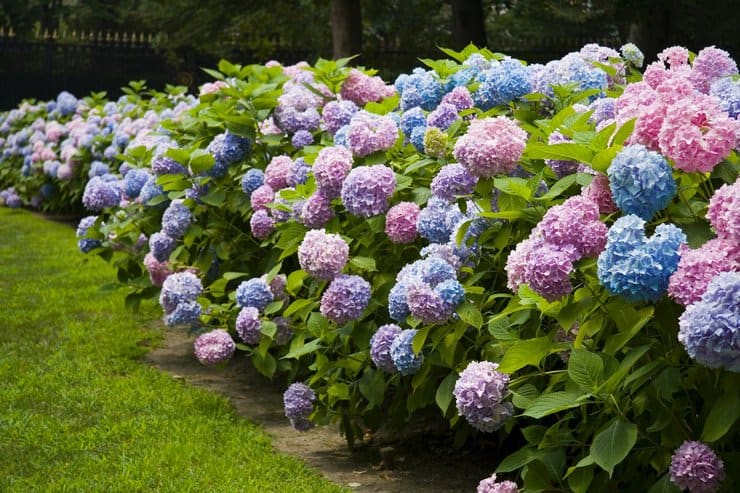
Hydrangea is generally a soil-demanding flower, and large-leaved varieties are even more capricious in this regard.
Therefore, it is necessary to take into account the following components:
- the planting site should be in a place in the garden that is illuminated by the morning or evening sun.Hydrangea should receive the sun's rays for at least 5-6 hours a day, but the bright midday sun does not suit it, with this kind of lighting the inflorescences lose their freshness and die. If you cannot find a site with such lighting, plant your bush in partial shade;
- hydrangea does not like clay soil and stagnant water, therefore, if your garden has such a soil composition, be sure to drain it. However, it is preferable to look for a place with light, loose soil;
- humus and peat must be added to the planting hole, on which a little earth is poured on top. It is necessary to plant a hydrangea in a planting pit with a prepared mixture, having well straightened its roots;
- it is necessary to plant a plant exclusively on a cloudy day, so that the bush has time to recover before the bright sun appears;
- after planting, the ground around you needs to be slightly compacted, it is well watered with warm water and mulched so that moisture in the soil is preserved. For the first time, a young plant should be slightly shaded. The cover must be removed after ten days, choosing cloudy weather for this.
- neither lime nor ash can be added under hydrangeas, this plant prefers to grow on acidic soils.

How to prepare hydrangea for winter
The complex of pre-winter preparatory measures consists of the following manipulations:
- cleaning;
- top dressing;
- watering;
- preventive treatment against diseases and pests;
- pruning;
- insulation.
A faded hydrangea bush needs to be thoroughly prepared for wintering
Territory cleaning
First of all, you need to put things in order in the bite zone. The land under the hydrangea bushes is freed from the plant debris accumulated during the growing season (fallen petals and leaves, twigs, etc.), all the weeds are chopped out, the earth is loosened to a depth of 2-3 cm. Everything collected must be burned.
Top dressing
At the very end of the season, it is necessary to fertilize the planting of hydrangeas for the last time, using potassium-phosphorus compounds (for one adult bush, for young plants the amount is half as much):
- potassium monophosphate - 50-50 g;
- potassium sulfate - 15–20 g and superphosphate - 35–40 g;
- complex autumn fertilizers (according to the instructions).
To feed hydrangeas, you can use a special mineral complex marked "Autumn"
In regions with severe climatic conditions, this is done around the middle of September; in the middle lane, top dressing can be applied until the end of this month. But in the south, hydrangeas should be fertilized in October. The granules are scattered under the bushes (in moist soil), shallowly embedded in the ground, or dissolved in a bucket of water and watered the plants.
Watering
If autumn is dry and natural precipitation is not observed, then hydrangeas should be watered regularly, spending 1-2 buckets per bush at least once a week. The soil under the bushes must be kept moist, but not swampy. With an excess of rain, the plants are covered with polyethylene. As soon as the air cools down to + 5 ... + 7 ° C at night, watering is reduced. With a further decrease in temperature to 0 ° C, it is completely stopped.
Treatment
In order to prevent various diseases and insect pests, hydrangea bushes are sprayed with Bordeaux liquid (3%) or copper sulfate (1%) after all the foliage has fallen (the temperature should not be lower than +5 ° C), and not only themselves are subject to processing plants, but also the soil under the bushes.
Pruning
The main pruning of hydrangeas is carried out both in spring and in autumn. Most growers prefer to prune the bushes in the fall, since after the spring pruning, there is a strong sap flow, which depletes the plants. But large-leaved varieties, as well as very young bushes (2-3 years), are not touched until spring.
It is better to cut off old inflorescences so that in winter the branches do not break under the weight of the snow that has fallen
In paniculate species, only the inflorescences are usually removed, and in the spring they do the rest. Treelike hydrangea can be cut off completely in the fall, shortening all shoots to 3-4 pairs of strong, strong buds.In large-leaved varieties, broken, twisted, damaged by pests or diseases and branches directed into the bush are removed, carrying out sanitary pruning.
Different types of hydrangeas are pruned in different ways.
Shelter for the winter
Treelike and paniculate types of hydrangeas do not need special insulation for the winter, because they can withstand cold temperatures down to -35 ... -30 ° C. Usually it is enough to pile up the bush well, throwing a hill of earth, humus or peat 20-25 cm high. But young (especially freshly planted plants) and large-leaved varieties must be well covered. Do this before the onset of persistent cold weather. When the air temperature stays in the region of -3 ... 0 ° C, work begins.
The approximate terms for the regions are as follows:
- northern latitudes (Siberia, Urals) - late September or early October;
- the middle lane (including the Moscow region) - mid-October;
- southern regions - November.
There are several ways to insulate a hydrangea:
-
The branches are carefully tilted, laid on the ground in a fan, then pinned with brackets, hooks, or simply pressed down with boards. Top covered with dry leaves and covered with several layers of agrotechnical.
-
The shoots are pulled into a bunch and fixed with twine, then wrapped in agromaterial.
-
A frame is installed above the bush, with a waterproof material stretched over it (film, roofing material, etc.). Dry leaf litter is poured inside the structure.
Our neighbor, who has a hydrangea bush on her site, at the end of September she lines the ground under the plant with several layers of roofing material, puts branches on it, pressing them down with bricks or stones. On top of all this, he installs a metal frame, pulls a spunbond over it, and then in November throws a large snowdrift on top.
Features of wintering of different varieties

Plants can be found on personal plots in the southern regions of Russia and in the Middle lane. The harsh climate of the Urals and Siberia is not suitable for growing these plants. There, the bush freezes out in winter, even if a shelter is organized. In general, the agricultural technology defined for a flowering shrub is simple, but certain rules must be followed. Some varieties must be covered in autumn, otherwise the flower buds will freeze, the buds will not form and flowering will not come. With a significant drop in temperature, the plant will die.
The most famous are large-leaved and panicle hydrangeas. Other varieties are less common in Russia. Wintering features differ significantly for different varieties:
- Treelike and Paniculate - tolerate frosts, quickly recover and start growing in early spring;
- Large-leaved - not resistant to low temperatures. A feature of the plant is flowering on old branches that can freeze slightly. To protect the formed buds from frost, it is necessary to provide shelter for the hydrangea for the winter.
- Ground cover or Himalayan is a winter-hardy variety that can grow in the Volga region, and with the organization of high-quality protection in Siberia and the Urals.
- Oakleaf is a whimsical variety with minimal resistance to cold. Recommended for cultivation in the south of Russia and the Crimea. In case of a sharp cold snap in a winter with little snow, it needs protection.
- Petiole - frost-resistant, additional protection is not required, the main thing is to qualitatively prepare the plant for the dormant period in the fall.

For your reference, hydrangea is a massive flowering shrub, reaching 1-3 meters in height. According to the specifics of the growing cycle, varieties are evergreen and deciduous. The latter are suitable for growing in cold climates.
Paniculate, petiolate and tree hydrangea
Treelike, paniculate and petiolate hydrangeas do not need additional shelter for the wintering period. These plants tolerate lower temperatures well.The peculiarity of the growing cycle is that flowering occurs on young shoots, respectively, spring haircut in order to remove frozen areas is beneficial to the culture.
The petiolate variety grows on a special support, and should not be removed for the winter. Liana quietly winters on props without freezing. Only young bushes that grow for 1-2 years need protection. Shoots can simply be laid on the ground. It is not necessary to cover them additionally, so as not to reduce the natural resistance to frost. This manipulation may seem simple as long as the vine is not large. Within a few years, manipulation will become labor intensive.
Large-leaved hydrangea
Hydrangea (hydrangia) paniculata requires additional frost protection. A similar condition is associated with the specifics of the flowering culture.
It is important for the plant to preserve the tops of last year's shoots, their pruning is unacceptable in case of frostbite. If the plant loses some of its branches, it will not bloom luxuriantly in the coming season.
There are varieties that are characterized by increased resistance: hydrangia Endless Summer Bloomster (pink) and Endless Summer Original (blue).
Features of hydrangea
First you need to get to know this plant and find out what it is. This culture belongs to the blooming ones. She really fell in love with gardeners from different countries for her adorable appearance. However, there is one small drawback for those summer residents who are in the northern cold regions. You will have to cover this wonderful plant during the cold season to protect it from death.

However, this rule is not only for residents of the northern regions. Many varieties of hydrangea need to be covered even in the middle lane. What varieties need insulation? For example, tree hydrangea and large-leaved. There are some varieties that need shelter only at a young age, for example, the panicle hydrangea variety.
Only summer residents from the southern regions were a little more fortunate. Here you do not have to cover the plant even for the winter, since the climatic conditions are quite suitable for wintering hydrangeas.
The time required for covering hydrangeas is different for different regions, due to their climatic differences.
Shelter methods for the winter
There are two ways to hide hydrangeas, but first you need to find out which variety you have planted in your garden.
If you have paniculate and tree-like varieties, then you do not need to cover them. If you are worried about your plant, then for the sake of safety net you can well spud the bushes in the fall, also scatter dry leaves near the trunk circle or put spruce branches. But all of these guidelines are only applicable to mature plants.

As for the seedlings, they, of course, will need to be completely covered for the winter, as well as the large-leaved hydrangea.
The procedure for the first method should be as follows:
- Before you start covering the plants, you will need to remove thin and overlapping shoots and collect any fallen leaves.
- Divide the bush, but at the same time it is worth considering which direction of the shoots the plant has, then tie it to the ground and secure it. Since the shoots of hydrangea are flexible, usually there is no breakage.
- Next, you should cover the plant with lutrasil or some other material, but it should be non-woven.
- Sprinkle with dry leaves on top and place a bag of sugar in the plastic wrap to prevent it from getting wet.
- At the end, you should throw on a piece of the old carpet. This completes the shelter of the first option.
The second way of hiding is as follows:
- You should put about 3 buckets of garden soil in the base of the prepared bush and in the place where the roots of the plant are located.
- You should put small wooden boxes next to the plant and lay the hydrangea shoots on them, you will also need to secure them using the slot of the supports.
- At the end, you need to cover the plant with several layers of material (agrospan), and cover it with a film on top.
Remember that it is best not to rush with the opening of the hydrangea, it can be harmed by recurrent frosts. The opening time of the hydrangea depends on the region in which you live. On average, hydrangea opens in late April or early May.

